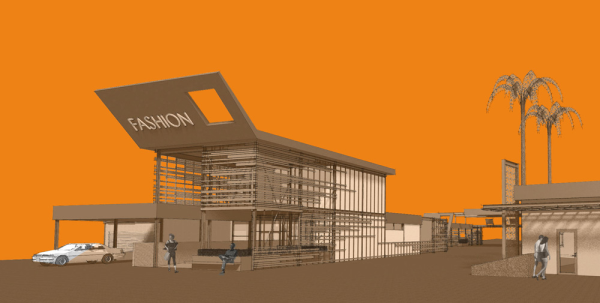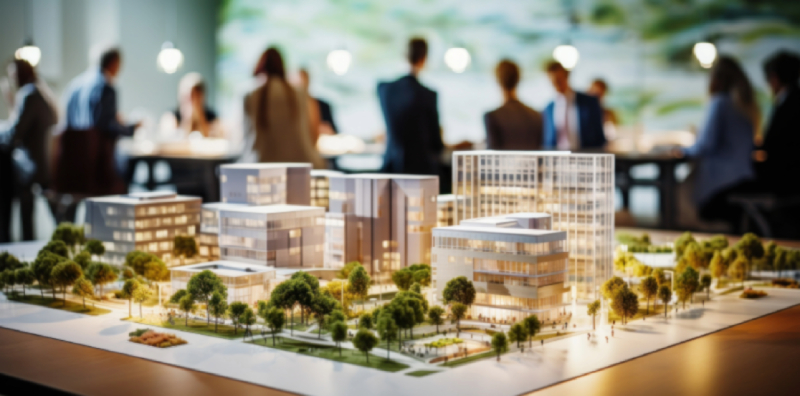Revealing the Comprehensive Providers Offered by Commercial Architects for Modern Advancement
Commercial Architects serve an important function in contemporary development projects. They mix style looks with performance while sticking to regulative demands. Their competence prolongs beyond simple building, incorporating sustainable methods and ingenious modern technologies. As they browse complex zoning laws, Architects work together with various stakeholders to bring visions to life. This multifaceted technique increases concerns regarding the evolving duty of Architects in shaping contemporary areas and the effect of their deal with future advancements.
Understanding the Duty of Commercial Architects in Modern Advancement
In modern metropolitan landscapes, Commercial Architects play an essential role in forming functional and visual rooms that satisfy diverse business demands. Their knowledge extends beyond simple layout; they navigate complicated zoning legislations, constructing codes, and ecological policies. By teaming up with customers, they recognize particular requirements, ensuring that each job aligns with the client's vision while likewise considering functional facets such as sustainability and cost-effectiveness. Commercial Architects are proficient at integrating innovative modern technologies and materials into their styles, improving both the performance and power efficiency of structures. They conduct complete website analyses to assess the potential challenges and chances offered by an area. In addition, effective communication with service providers and various other stakeholders is essential, ensuring that the job progresses smoothly from conception to completion. Ultimately, Commercial Architects contribute in producing spaces that not only accomplish practical objectives but likewise add to the general personality and vibrancy of metropolitan settings.
Concept Layout: Changing Ideas Into Reality
Concept style acts as an important phase in Commercial architecture, where innovative design solutions arise from creative thinking. This process counts on collaborative ideation, combining diverse perspectives to fine-tune and enhance preliminary ideas. As concepts form, they transform from abstract notions into substantial building facts.
Innovative Style Solutions
Changing ideas into fact is the hallmark of innovative style services in Commercial style. These services blend imagination with functionality, resolving the unique demands of modern-day developments. By leveraging innovative innovations and lasting techniques, Architects craft spaces that are not just aesthetically attractive but additionally reliable and adaptable. Emphasis on individual experience drives the layout process, making certain that settings foster efficiency and partnership. Each task advantages from a customized approach, where ideas are diligently established to mirror the customer's vision while considering future trends. Cutting-edge layout solutions also focus on adaptability, enabling modifications over time as company requirements develop. Inevitably, these strategies enhance the overall worth of Commercial areas, making them essential in today's affordable landscape.

Joint Ideation Refine
Partnership acts as the foundation of the ideation procedure in Commercial architecture, cultivating creative thinking and advancement amongst diverse stakeholders. Architects, clients, engineers, and community participants take part in vibrant discussions, ensuring that all perspectives are considered. This comprehensive technique allows for the expedition of different layout concepts, encouraging distinct remedies that line up with the project's vision. Via workshops and conceptualizing sessions, concepts evolve and improve, changing preliminary principles into concrete layouts. Innovation additionally plays an essential duty, with devices such as Structure Details Modeling (BIM) promoting real-time partnership and adjustments. Inevitably, this joint ideation process not just improves the design outcome yet also cultivates a feeling of ownership and investment amongst all events involved, leading to effective Commercial developments.
Zoning Evaluation: Browsing Regulations and Conformity
As programmers start on brand-new tasks, comprehending zoning regulations is vital to making sure compliance and staying clear of pricey delays. Zoning evaluation plays an essential function in this process, as it involves evaluating regional zoning legislations that dictate land usage, constructing elevation, density, and problems. Commercial Architects have the competence to browse these complex policies, aiding customers identify permissible uses and any required differences.
Sustainable Style Practices: Structure for the Future
Sustainable design practices are significantly vital in the domain of Commercial style, especially as ecological worries remain to escalate. Architects prioritize environment-friendly materials, energy-efficient systems, and layout strategies that minimize waste and environmental influence. Including renewable resource resources, such as photovoltaic panels and wind generators, allows buildings to produce their very own power and decrease dependence on fossil fuels.Furthermore, sustainable design stresses the value of interior ecological top quality. This consists of utilizing natural light, improving ventilation, and selecting safe materials to improve resident health and efficiency. Eco-friendly roofs and you can try these out living wall surfaces are also prominent attributes that add to biodiversity and metropolitan cooling.Additionally, Commercial Architects commonly incorporate water preservation strategies, like rainwater harvesting and drought-resistant landscape design. With these innovative methods, they develop spaces that not only fulfill modern requirements but also cultivate a lasting future, dealing with the growing need for accountable development in the modern globe.
Job Management: Ensuring Timely and Effective Implementation
Reliable job monitoring is important for ensuring that Commercial design projects are finished on schedule and within budget. This function includes a variety of duties, including the sychronisation of numerous stakeholders, timelines, and sources. Commercial Architects utilize their expertise to produce thorough job plans that lay out essential milestones and deliverables, permitting for organized development tracking.Regular communication among team members and customers is crucial, promoting transparency and helping with punctual decision-making. Danger monitoring approaches are also employed to identify prospective obstacles early, allowing positive services to be developed. By using sophisticated job monitoring tools, Architects can keep an eye on project efficiency in real-time, making adjustments as essential to maintain effectiveness.
Interior Decoration: Developing Practical and Aesthetic Spaces
Inside style plays an important function in boosting both performance and aesthetics within Commercial areas. Effective space preparation can maximize process and boost customer experience, while aesthetic design concepts contribute to an aesthetically attractive atmosphere - commercial architects. Together, these components develop areas that are not just functional however likewise inspiring
Room Preparation Effectiveness
While making the most of the utility of offered space, Commercial Architects focus on room preparation effectiveness to develop both useful and cosmetically pleasing environments. This approach includes careful evaluation of the spatial layout to ensure ideal use of every square foot. Architects think about factors such as workflow, ease of access, and natural light to boost use. By strategically putting furniture, equipment, and workstations, they help with motion and communication among customers, promoting performance. Additionally, zoning different areas for details features assists in taking care of noise and personal privacy, producing a harmonious environment. Through reliable area planning, Commercial Architects can transform constraints right into possibilities, making sure that each area fulfills the varied needs of its passengers while sticking to regulative needs and industry requirements.
Visual Layout Principles
Visual layout principles play a necessary function in shaping environments that are not only practical yet likewise visually enticing. These concepts assist Commercial Architects in creating areas that resonate with users while boosting brand identification. Key elements consist of balance, proportion, and consistency, which interact to produce a cohesive look. Color pattern and materials are very carefully chosen to stimulate desired emotions and sustain the total motif. Additionally, illumination plays a crucial function, influencing state of mind and visibility while highlighting building functions. By incorporating these principles, Architects guarantee that rooms are not just useful but additionally welcoming and inspiring. Eventually, efficient aesthetic style fosters a positive customer experience, motivating engagement and complete satisfaction in Commercial environments.
Partnership With Stakeholders: Cultivating Effective Partnerships
Effective collaborations in Commercial style rest on efficient partnership with stakeholders, making certain that every voice is listened to and valued. This collective technique entails appealing different parties, including clients, contractors, and neighborhood participants, throughout the layout and development procedure. By cultivating open interaction, Commercial Architects can deal with problems, collect understandings, and align the job's vision with stakeholder expectations.The combination of varied point of views boosts creativity and technology, bring other about more functional and visually pleasing designs. Regular conferences, responses sessions, and workshops promote this dialogue, enabling Architects to adjust their plans in reaction to stakeholder input. On top of that, establishing trust with openness and responsibility enhances these collaborations, causing a smoother job execution.Ultimately, the success of contemporary advancements depends upon the Architects' capability to browse and balance varying rate of interests, creating a collaborative environment that promotes common goals and mutual success.
Regularly Asked Concerns
Just How Do Commercial Architects Handle Budget Plan Constraints During a Project?

What Kinds of Software Do Commercial Architects Commonly Use?
Commercial Architects generally use software program such as AutoCAD for preparing, Revit for Building Information Modeling, SketchUp for 3D modeling, and job monitoring tools like Microsoft Project to improve collaboration and improve operations throughout the layout procedure.
Can Commercial Architects Assist With Obtaining Funding for Projects?
Commercial Architects can help in obtaining funding for projects by preparing in-depth propositions, helping to articulate layout visions, and providing financial forecasts that can enhance the possibility of safeguarding necessary funding from financiers or monetary establishments.
Exactly How Do Architects Make Sure Safety And Security Throughout the Building Refine?
Architects ensure security throughout construction by applying extensive layout criteria, collaborating with designers, carrying out normal site inspections, adhering to regional guidelines, and promoting communication among all stakeholders to alleviate threats and advertise a safe and secure functioning environment.
What Ongoing Assistance Do Architects Supply After Job Conclusion?
After job completion, Architects use ongoing assistance with maintenance appointments, efficiency evaluations, and layout check here modifications. They ensure buildings satisfy evolving needs, address potential concerns, and maintain conformity with guidelines, cultivating a long-term partnership with customers.